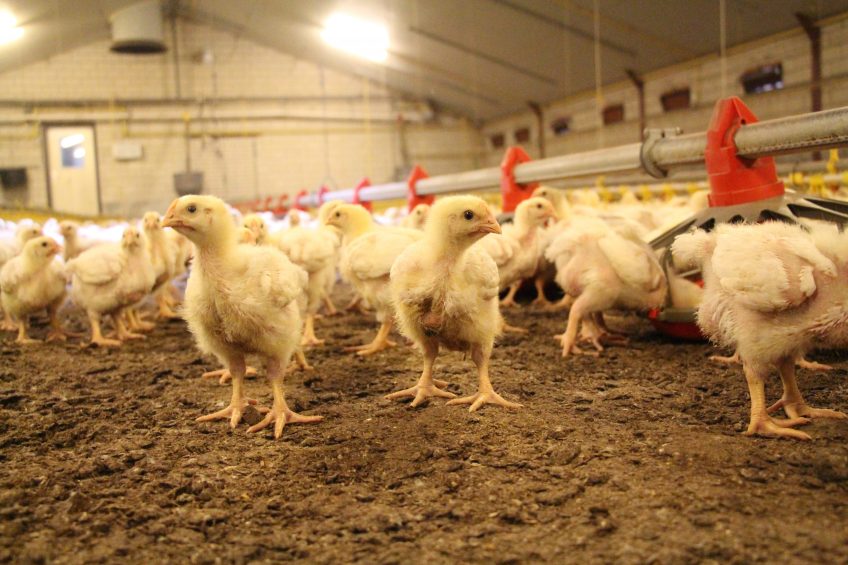Recognised amongst the world’s best

To their surprise Patrick and Elvera van den Hurk were ranked among the 3 winners of the Cobb Champion 2016 award, which Cobb introduced last year. What does it take to be ranked amongst the world’s best?
The Cobb Champion 2016 award is an award for outstanding poultry production performances, which was introduced by breeding company Cobb. Patrick van den Hurk had a lot of contact with both Ross and Cobb in his job for the Coppens animal feed company in the Netherlands. “During one of the meetings with Martijn Gruyters and Wout van Wolfswinkel of Cobb, the question whether or not we wanted to try out Cobb chicks on our own farm popped up. Just to see how this bird is performing and whether it can compete with Ross. I can compare it, as we can meticulously measure the results per house using data.”
68.8 grammes per day
Since July 2016 the family has had 3 rounds of Cobb chicks in a row in one house. Elvera takes care of the chicks. Then – in early 2017 – the family started a flock of Cobb chicks in 2 houses. Patrick says, “The chicks that we started on 5 September 2016, that was the 2nd round, was the winning flock that performed extremely well.” According to Elvera she just took care of the chicks. Elvera smiles: “I just try to rear prize winning chicks each round – whether they are Ross or Cobb chicks.” Van den Hurk’s winning flock of Cobb chicks comprised of Cobb500 chicks hatched by hatchery Probroed & Sloot. Patrick says, “The winning flock grew up to a weight of 2.68 kilogrammes in 39 days, with an average daily gain of 68.8 grammes and a feed conversion of 1,51, or an EPEF (European Production Efficiency Factor) of 443. Thus far I haven’t accomplished an average daily gain of 68.8 grammes with Ross chicks.”
Differences: Cobb and Ross
With their management system the family can analyse almost like a research company. Patrick states, “We measure everything per house. This provides us with 6 times a result per round. This clarifies the moments of a round that have room for improvement.” Regarding Cobb and Ross, Patrick have experienced that Cobb chicks need a little more attention at the start, but catch up after that (2nd to 4,5th week) and eat faster than Ross chicks during that period of time. He also sees that Cobb chicks have a stable gut. “This is something Elvera and I can determine by looking at the manure. Together with employee Rob, Elvera checks manure quality and feed intake twice daily,” Patrick adds.
The fact that the 2nd Cobb flock performed this well, may be due to several factors. The winning flock was included in field tests that the family did with a new pre start feed called Ready. “This might have contributed to the extremely good results. This new pre start feed contributes to a more stable gut and less digestive problems,” he says.
Good management very important
Also the family’s management will undoubtedly have contributed to this top result. At the farm all houses are equipped with Stienen climate computers, which are all connected via Farm Connect. The climate in the houses is controlled by the climate computer, which also measures the amount of CO2 and the Rv, and adapts when necessary. If needed the family adjusts ventilation. Moreover, there is intensive consultation between the family and the veterinarian of Dierenartsen Midden Brabant (DAMB) and Coppens’ animal nutritionist. “Our animal nutritionist can log into Farm Connect and regularly enter the house in order to take a look at the animals. Together with the veterinarian he determines an anti coccidiostats programme. We deliver customised solutions to improve the performances of each round. If you want to perform like we did with the winning flock, everything must be right,” states Patrick. Since 1996 the family adds approximately 27% of wheat to the feed, also in relation to a better chick health. “This makes a difference of about 2 to 3 cents per chick.”
|
Peat as bedding
“In our experience Cobb chicks also score slightly lower on foot pad lesions than Ross chicks. In our case the prevalence of foot pad lesions has not dropped dramatically since we use peat as bedding. Other (management) factors play a big role in a low foot pad lesions score.” Two other important reasons why the family uses peat are fire safety and its low price, as it is cheaper than wood shavings. Another remarkable management element is the fact that the family chooses to unload twice intermediary. The results are subject to the chicks1 genetics. Patrick: “But that is something I can’t influence. I can influence the vaccination schedule, which is something we pay a great deal of attention to. Before vaccinating we take up the water line and tap water until the vaccine reaches the end of the line before we let the water line down again.” Prior to the arrival of the chicks there is contact with the hatchery in order to inquire about the performance of sister flocks. Elvera says, “We also check the chicks upon arrival. We check their weight, uniformity, temperature and whether or not their navels are closed.” When the family is in doubt, they immediately call the veterinarian in order to discuss what to do. In the starting phase of the chicks, Elvera adjusts the temperature in the house on a daily basis when needed, based on the chick temperature.
To read more articles from the latest issue, go to the magazine overview page and sign up with your current website login.


 Profile:
Profile:









